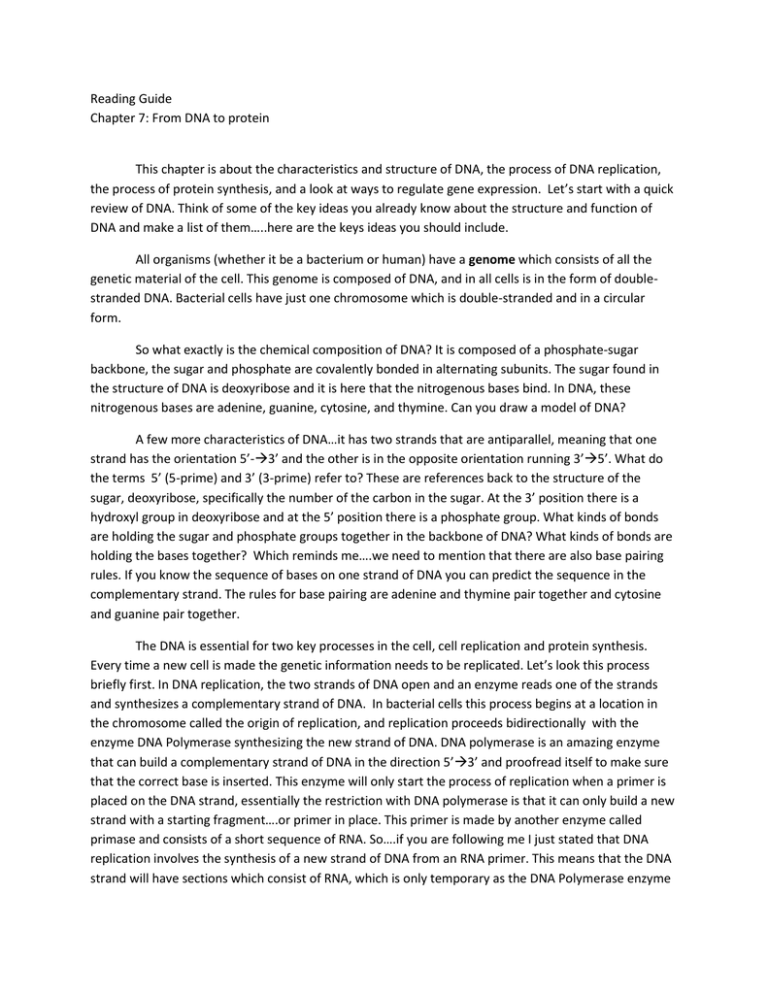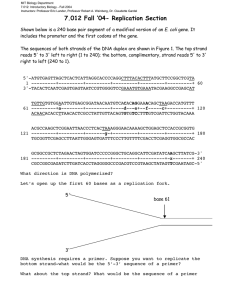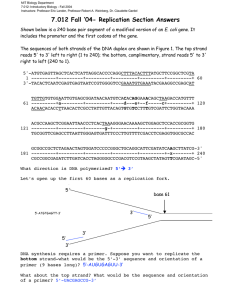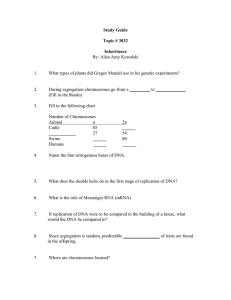Reading Guide Chapter 7: From DNA to protein
advertisement

Reading Guide Chapter 7: From DNA to protein This chapter is about the characteristics and structure of DNA, the process of DNA replication, the process of protein synthesis, and a look at ways to regulate gene expression. Let’s start with a quick review of DNA. Think of some of the key ideas you already know about the structure and function of DNA and make a list of them…..here are the keys ideas you should include. All organisms (whether it be a bacterium or human) have a genome which consists of all the genetic material of the cell. This genome is composed of DNA, and in all cells is in the form of doublestranded DNA. Bacterial cells have just one chromosome which is double-stranded and in a circular form. So what exactly is the chemical composition of DNA? It is composed of a phosphate-sugar backbone, the sugar and phosphate are covalently bonded in alternating subunits. The sugar found in the structure of DNA is deoxyribose and it is here that the nitrogenous bases bind. In DNA, these nitrogenous bases are adenine, guanine, cytosine, and thymine. Can you draw a model of DNA? A few more characteristics of DNA…it has two strands that are antiparallel, meaning that one strand has the orientation 5’-3’ and the other is in the opposite orientation running 3’5’. What do the terms 5’ (5-prime) and 3’ (3-prime) refer to? These are references back to the structure of the sugar, deoxyribose, specifically the number of the carbon in the sugar. At the 3’ position there is a hydroxyl group in deoxyribose and at the 5’ position there is a phosphate group. What kinds of bonds are holding the sugar and phosphate groups together in the backbone of DNA? What kinds of bonds are holding the bases together? Which reminds me….we need to mention that there are also base pairing rules. If you know the sequence of bases on one strand of DNA you can predict the sequence in the complementary strand. The rules for base pairing are adenine and thymine pair together and cytosine and guanine pair together. The DNA is essential for two key processes in the cell, cell replication and protein synthesis. Every time a new cell is made the genetic information needs to be replicated. Let’s look this process briefly first. In DNA replication, the two strands of DNA open and an enzyme reads one of the strands and synthesizes a complementary strand of DNA. In bacterial cells this process begins at a location in the chromosome called the origin of replication, and replication proceeds bidirectionally with the enzyme DNA Polymerase synthesizing the new strand of DNA. DNA polymerase is an amazing enzyme that can build a complementary strand of DNA in the direction 5’3’ and proofread itself to make sure that the correct base is inserted. This enzyme will only start the process of replication when a primer is placed on the DNA strand, essentially the restriction with DNA polymerase is that it can only build a new strand with a starting fragment….or primer in place. This primer is made by another enzyme called primase and consists of a short sequence of RNA. So….if you are following me I just stated that DNA replication involves the synthesis of a new strand of DNA from an RNA primer. This means that the DNA strand will have sections which consist of RNA, which is only temporary as the DNA Polymerase enzyme will remove these sections of RNA and replace them with DNA. A few other terms…the replication fork is the place where replication is occurring. There are other enzymes involved in the process of DNA replication, helicases and DNA gyrase are important in unwinding the strand so that replication can proceed. One more thing about DNA replication. Remember the enzyme DNA Polymerase can only synthesize a new strand in the direction 5’3’, if the DNA is double stranded with the strands in antiparallel orientation, how does this happen? What is meant by the terms leading and lagging strands of DNA? Can you describe the process of replication of these two strands? (Use Fig 7.6 as a guide). DNA is also essential for gene expression in cells. Gene expression is used to describe the process of protein synthesis, which includes transcription and translation. Transcription is the first step towards synthesis if a protein and requires the enzyme RNA polymerase and the DNA (as a template). Since we are synthesizing only one strand of RNA in the direction 5’-3’, the enzyme will bind to the appropriate strand of DNA to generate a single strand of RNA. This process begins at a sequence in the DNA called the promoter region and continues until the terminator sequence in the DNA is reached. It is the promoters that regulate the direction of transcription, or rather indicates which of the DNA strands is to be read by RNA Polymerase. Once the process of transcription is complete…what do you have? A strand of RNA! This strand of RNA is then processed through translation, where we have synthesis of a protein as the final product. The steps in this process are not as important as understanding what components are necessary. For translation you need your mRNA strand, amino acids, ribosomes, and tRNAs. The mRNA associates with the ribosomes





